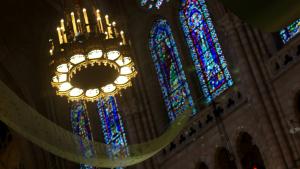Can I Welcome New Life?
 Christ is risen!
Christ is risen!
Christ is risen, indeed!
Blessed Easter to all, this Sunday culmination of what has been a hard 40 days, full of questions here at The Riverside Church internal questions guiding our practice of discipleship during the season of Lent. Every week this Lent the text would ask us another question: Can I resist temptation? Can I give up my life? Can I admit I’m wrong? Can I forgive? Can I be open? Can I step up?
Today is Easter Sunday, Lent is over…so you’d think I’d be here today with an answer instead of a question, but I’m afraid the text won’t let us rest. Today our question is: Can I welcome new life? The profound gift and mystery of Easter is that God meets us in places of deepest darkness and death, realities of human living, and always, always offers us the possibility of new life. The question confronting us today is whether or not we will welcome the possibility of resurrection, and step into all that it offers for us, for our world.
Can I welcome new life?
In the small community of Swift Creek, South Carolina, it is an annual tradition for the entire town to show up at the cemetery very early on Easter morning for an Easter sunrise service. While the rest of the year, the Presbyterians and Baptists and Episcopalians worship in their own church buildings across town from each other, every Easter Sunday morning before dawn everybody gathers in the pitch dark to worship together while the sun gradually rises over the surrounding hills.
One year, just like every other year, all the Christians in town (which, as you might imagine, was a group of pretty much everybody who lived in Swift Creek, SC) crowded into the small town cemetery, standing around awkwardly, waiting for that beautiful moment when they would all sing “Christ the Lord is Risen Today” while the sun came up with the stunning visual reminder of resurrection.
As they stood there in the dark, the typical service unfolded. The music minister from the Lutheran church led the first hymn, the Baptist preacher prayed. The service went on as planned, until it was time for the sermon—which was the responsibility of the Methodists that particular year. But it was still dark, so the Methodist minister went to his car and found a flashlight, then tried to hold it while juggling his sermon notes. After the sermon someone else prayed, they sang a final hymn, and another one of the town’s preachers gave the benediction to bring the service to a close.
Awkwardly, when the last “Amen” was said, it was still dark; the sun had not even begun to come up.
Turns out Easter was very early in March that year, before daylight savings time, and the sun would not even begin to come up for another whole hour. But nobody thought to check. The people of Swift Creek, SC came out to celebrate resurrection in the dark, and when it was over they trudged back to their homes…in the dark.
If I ever consent to leading an Easter morning sunrise service, which is highly unlikely, I will be sure to double check what time the sun is supposed to rise. But I thought the story of the Swift Creek eccumencial Easter morning sunrise service was fitting for us today, because for all the lilies, beautiful new Easter clothes, bunnies and triumphant music, the truth is that, like the women at the tomb early that morning, we are grappling with the reality that Easter new life begins…with death.
Can I welcome new life?
It’s the text that raises the question for us this morning…you’ll recall the two men in dazzling clothes, Luke says, pose a question to the women, bowed to the ground, shaking in fear, wondering if they were next: Why are you looking for the living among the dead? In other words: can you summon from deep inside your weary, grief-worn bodies and hearts, the possibility of new life?
Notice that our gospel story of resurrection begins at the first verse of Luke’s gospel, chapter 24 with a little word that changes everything. After a horrifying three days, Jesus whom they’d loved, had been interrogated, tortured, killed…after the women cried at the foot of the cross and cared for his dead and broken body, then sealed the tomb to go home for the sabbath…after they fell into exhausted sleep then woke on the dark edge of dawn only for the memories to come rushing back as reality set in…after all of that, they made their way back to finish Jesus’ burial. And Luke begins chapter 24 with this word: but.
But…when they got there, the women didn’t find a body, and they remembered Jesus’ strange words about resurrection. But…when they heard the witness of the shining men in the tomb, they realized they were locked in the darkness of death, unable to welcome the possibility of new life. But…when they ran to tell the men that resurrection was unfolding right in front of their eyes and the men dismissed their report as an idle tale…they decided that death would not be the end to the radical gospel message Jesus came to teach.
They decided they would welcome new life.
Martyred Archbishop Oscar Romero, from El Salvador, said: “There are many things that can only be seen through eyes that have cried.” And that’s how resurrection–new life–made its way into the world that morning. Unlike the other stories of resurrection in the gospel accounts, Luke’s story doesn’t say that anyone instantly believes. There’s no Jesus, appearing just in the nick of time to help them overcome their doubt. There’s no moment of clarity in which everybody’s perception is overturned.
No, it happens gradually, as the story is told, over and over. First the women, stumbling to the tomb in the dark, encountering resurrection through the witness of the shining men in the tomb…then the women going to the disciples, telling their story of resurrection to a doubting group…then Peter, struck by the women’s witness, heading to the tomb. It all started there, this witness to resurrection.
And, shortly after Easter day, the disciples all started bearing witness, going around telling this incredible story of Jesus’s death…and the miracle of his resurrection. They told the story over and over in the weeks that followed and little groups of people began to form, telling each other the story of resurrection again, bearing witness to God’s presence and the hope of life over death. Together they decided to face down the darkness, to stand up to death, to…welcome new life.
And slowly, slowly as it did that first Easter morning, resurrection became reality for people who needed to know the truth of God’s work in this world: that death is real…but that death is not the end.
Why are you looking for the living among the dead? Can you welcome new life? Can I welcome new life? Here we sit, 2000 years after that dark Easter morning, when the story unfolded and the first ones who experienced resurrection had the courage to bear witness to it. If we listen to their witness, we’ll begin to remember, if we try, that themes of resurrection run through our lives, all the time. God is well at work in this world and in us. Every one of us has a resurrection story to tell.
Can you welcome new life?
One of my favorite resurrection stories in modern literature unfolds in Alice Walker’s Pulitzer Prize winning book, The Color Purple. The story of sisters Celie and Nettie is told in the form of diary entries and letters, and the story begins with Celie, a poor young black woman in 1930s Georgia, who has been the victim of abuse her whole life long. Celie is forced into a marriage to an abusive husband against her will, and Celie and her sister Nettie go to live with him. Things get really bad, and Celie pleads with her sister Nettie, dearest person in her pain-filled life, to leave and go to the home of a local pastor to make a new life for herself. Nettie leaves in a heart-wrenching goodbye, all the while promising to write to Celie.
Time passes…no letters arrive.
In her hopelessness and despair, Celie begins to believe that Nettie has died. After all, what other scenario would make any kind of sense? There was no word from Nettie; there was no evidence she was still alive; it’s likely that the pain and horror of the lives they lived had just gone and swallowed her right up.
Then, one day, Celie finds a packet of letters Nettie has written over all these years, letters hidden by Celie’s husband who preferred that Celie live in hopelessness and desperation.
Pulling the precious letters from their envelopes one by one, Celie could hardly believe that Nettie had been alive all this time. Her words of love poured from the pages, like a soothing balm on a broken life. Just the thought, just the possibility that it might be true, changed everything for Celie. She read the final letter in the stack:
“Dear Celie,” Nettie wrote, “I know you think I am dead. But I am not. I been writing to you, too, over the years, but your husband said you’d never hear from me again and since I never heard from you all this time, I guess he was right. There is so much to tell you that I don’t know, hardly, where to begin…. but if this do get through, one thing I want you to know: I love you, and I am not dead.”
Today we’re confronted with the question of whether we have the courage to take our own tentative experiences of resurrection…the ways in which we know God is real and at work in this world and in our lives…and take the radical risk of welcoming new life.
All the voices around them told the women at the tomb that morning that what they believed was just an idle tale. And all the pain of our lives and the desperation of this world might also lead us to believe that resurrection is nothing more than wishful thinking, the stuff of religious zealots and optimistic dreamers, an idle, useless tale. Because sometimes Easter morning comes and goes in the dark, and, confronted with death and despair on all sides, we feel unable to remember the Easter miracle of resurrection. But…but….
But, as we gather this morning to remind each other that Christ is risen, Christ is risen, indeed, we know deep down that the resurrection we need . . . the resurrection our world so desperately needs . . . is certainly, definitely, surely, so much more than just an idle tale.
In fact, it’s God . . . .
Can you look through the pain of your life and the desolation of this world and summon the courage to welcome new life? God is reaching across human experience, through a story of torture and death and hopelessness, over two thousand years of you and me and so many others stumbling from the darkness and the graves of our lives terrified, tentatively and courageously gathering the courage to welcome new life. The story of the women at the tomb is a reminder on this day of resurrection:
“I love you,” God wants us to know . . . “and I am not dead.”
Can you welcome new life?
Amen.












